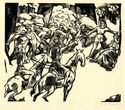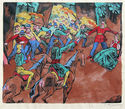
19th, 20th & 21st Century Fine Prints
707-546-7352 · fax 707-546-7924 · web: www.annexgalleries.com · email: artannex@aol.com
Franz Jansen Biography
Franz Jansen
German
1885–1958
Biography
Painter and printmaker Franz Maria Jansen was born in Cologne, Germany, in 1885. He studied architecture at the Technical University in Karlsruhe from 1905 to 1906 before switching to paintings, and he obtained his Masters degree at the Vienna Academy of Arts in 1910. His work was inspired at this time by Art Nouveau and Symbolism, all of which greatly influenced his graphic work and established the style he would become known for. However, following graduation he took a year to travel throughout Europe, exposing himself to the works of Expressionists and other new and often controversial styles of the time. His own painting style was reminiscent of the works of artists such as Magritte, whose Surreal dreamscapes were echoed in Jansen's paintings prior to World War II.
In the late 1910s, before and during World War I, he became active in the sociopolitical facet of Germany's art world, and he cofounded the Cologne Secession in 1910, the Gereonsklub in 1911, and the the Berlin Secession. In 1918 he wrote the manifesto About Expressionism, denouncing the art world's need for labels and calling for artists of all genres to concern themselves with social politics in their art. He worked as an illustrator for the progressive publication Die Aktion published by Franz Pfemfert.
Jansen exhibited his graphic works at international shows in the late 1920 and early 1930s, including in Paris, Zurich, Amsterdam, Warsaw, Cleveland, Detroit, Chicago, and Buenos Aires. When the Nazi regime began to expand, much of his work was confiscated and deemed degenerate, and he restricted his work to subjects deemed appropriate by the nationalist government in order to avoid punishment or banishment. He would eventually be commissioned to paint various murals for the German military, allowed in exchange for avoiding the draft.
Jansen was intrumental in helping to rebuild the art community of Berlin after the war, though he never achieved the fame of many of his Weimar-era peers, such as George Grosz, and he was a cofounder of the Rheinisch-Berisch artist's group. Jansen continued to work until his death in May of 1958. A posthumous retrospective of his work was shown in 1959's documenta 2 exhibition in Kassel.



